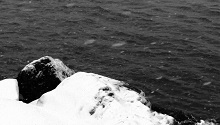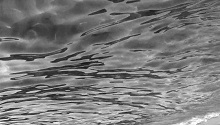Laura F. Gibellini
It is difficult to record the drops of water in the sea, the slightest wisps of clouds, the air of which stones are formed; it is difficult to quantify the spume of subtlety; it is very difficult to be Laura F. Gibellini.
It is fascinating to watch Laura F. Gibellini. The artist is that small, wild, beautiful, pacific animal we find in a remote spot, intent on exotic chores that are unknown to us and hard to understand, but which we feel to be everyday and necessary.
Laura works quietly and minutely; she does not invent, interpret or manipulate. The artist discovers and reveals, passing through objective, parallel worlds that unfold in the layers that underlie the shared reality perceived by our gaze. In her body of work, everything is pertinent, indispensable, necessary, and almost imperceptible. All the Japan of the Edo period is here, in the order and method she brings to it, in its successive layers and its transparencies, in this polishing, cleaning, finding and discovering, in the care with which she draws each line, cuts, strips or adds.
Laura F. Gibellini can give us the profile of an entire continent in a fine golden line, clouds heavy with storm on a small sheet of ruled paper alongside clusters of ductile rocks that respond to the measure of the sky. Using just chalk, Laura brought the waves of the ocean into the Marquis of Pombal Palace.
Layer upon layer upon layer of objective reality, hours of scientific thought, artistic thought, technical expertise and meticulous procedural humility. The intuitions and perceptions of Laura F. Gibellini are cracks that take us to the heart of the universe. Her work is transcendent.
Marta Moriarty, December 2015
Laura F. Gibellini is a visual artist and doctor of Fine Arts, and teacher of critical theory at the School of Visual Arts (NYC). Gibellini’s work grapples with the notion of place and what it means to inhabit the world. Recently, questions such as impermanence, invisibility and the difficulty of representing the fluid nature of the world around us have become prominent in both her theoretical and her artistic practice.
The artist’s most recent projects include the permanent public art installation DOM (Variations) in the New York subway; Notes on a Working Space at El Museo de Los Sures, NYC; the Slowtrack project Antes del Océano at Carpe Díem Arte e Pesquisa in Lisbon, and the solo show De Rerum Natura at Slowtrack, Madrid.
Attitude I. Water, by Laura F. Gibellini
In Liquid Modernity (and later books), Zygmunt Bauman used the term “liquid” to refer to a floating contemporaneity, with no fixed certainties and no stable structures. According to the sociologist, politics, society, art and even our personal lives have been immersed in a process of liquefaction and growing uncertainty. What might seem a dismal scenario is quite the opposite: in a context in which barriers become porous, set limits fade, and the solidity of absolute truths crumbles, a new horizon of multiple, vaporous possibilities comes forth.
In the aqueous medium, Laura F. Gibellini finds a habitat packed with potential, with unlimited possibilities, both conceptually and methodologically. For Pantalla CCCB, a month, an artist, the Spanish-Italian artist presents a series of videos that aim to record water at a specific instant; fragmented recordings at a given moment of a medium that is changing and, as such, ungraspable in its totality. However, the fact that a wave in the ocean is slow does not detract from the scope of its destination. And the very water that resides in that wave, in that instant, fades and is reproduced in another ocean, another river, another sea. This fluid condition of water and its imperceptible transit is what makes Attitude I. Water so thought-provoking.
In this way, theory, intuition and practice come together with a single objective in the most recent work of Laura F. Gibellini: the reproduction of the unrepresentable, or, more specifically, an exploration of how to think about something which, with no stable image or images, can be (un)thinkable. Using water as content and tool, her approach to this element is, a priori, furtive, capturing its essence from afar, almost like an observer. Laura F. Gibellini does not appear in any of her videos (as Ana Mendieta would); water is not an excuse, it is the motive. Nor is water subjected to manipulation or physically captured to turn it into a sculptural object, as other artists have done, like Hans Haacke (Rhinewater Purification Plant, Condensation Cube), or Bill Viola in much of his work.
Gibellini observes analytically to show what she still considers “annotations”, notes for a final conclusion that does not necessarily come. Using a cross-sectional study carried out in different parts of the world (New York’s Brooklyn, and Tuscany in Italy), the artist captures “free” water in multiple points of its hydrography. The recording is partial and fragmented, like the ice melting in the East River, in time to an ocean that is struggling under the layer of the frozen river and that we can only imagine, even though we know it is there.
The nine videos, all 2’32’’ long, are live image and audio recordings. Editing is practically nil, used only to manipulate the length. In those cases where this does happen, the spectator perceives a slight temporal contraction of the retina, but the poetic subtlety of what is recorded prevents us really noticing the manipulation. Attitude I. Water is a “collection” of notes, studies of representation: there are lines, dots and, in some cases, colour, though, except in Mediterráneo 5. 03.09.14-07.05.15, the only video recorded in colour, it does not feature naturalistically. East River 2 (With Color). 16.03.2015-07.04.2015 and East River 3 (With Color) 05.03.2015-07.04.2015 feature brief notes of colour (in the form of bars, almost like a test card, and dots or splashes). Layers of volumes, of superficial and internal currents, of zoomings in and out contribute to an organic movement that speaks to us through our bodies and biorhythms.
Made during the artist’s residency at El Museo de los Sures (New York), in 2015, these studies of the surface of water are the basis of Gibellini’s present-day pictorial research. The colours born of them make up the artist’s current basic pantone and represent a deliberate introduction of colour into her work. Furthermore, she uses the geometries borrowed from the natural elements she records, from which she “takes notes”, like the straight lines, rendered diagonal by the wind, that snow falling on the water draws in her sketches and research today.
Finally, there is also a consideration of time in the series, an apparently unordered, turbulent time, that can occur simultaneously. As the philosopher Michel Serres points out, it is the confusion between time and the “measuring of time”, as a metrical reading on a straight line, that generates the idea of a time that passes, that flows in one direction. If we disregard this linear conception, two events that are apparently distant—in time—can coexist and engage with each other. Likewise, it is possible to imagine that a wave that is generated in the East River in New York is impelled by another in the Atlantic Ocean.
Together, the videos generate a space of serenity, the only intervention being the acoustic influx of the soundscape that accompanies the images. At times, this reinforces the confusion and the fading visually offered by the interplay of greys against the background of the sea. At others, it indicates intense physical activity close at hand—perhaps a wave breaking on the rocks we saw. What we perceive is, again, a fragment that is gradually altered by the increasingly intense spume of the breaking wave, to return once more to a calm that is alien to this setting, delicately framed in the space of a wave and its surroundings.
On other occasions, the flashes of light that escape and shine out from the intensity of the black and white sparkle on the water, touched by the powerful intervention of the sky (and air) element, taking us once again to a detail that causes the water to boil in its final breaking and tell of what we do not perceive but which is there, nonetheless. In the Mediterranean, the waves adopt an unreal to-and-fro, to the rhythm of an overturned gravity, sinuous salinized water, oily almost, that is outlined to the rhythm of contemporary dance, physical poetry following a secret choreographer: the wind as guest stage manager.
Text by Marina Vives, critic and curator










